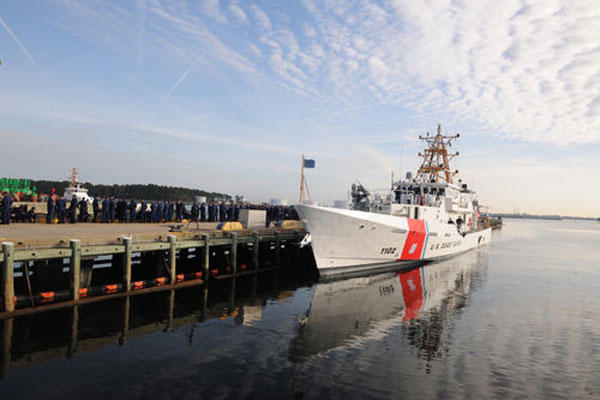On a warm December day, in Manteo, N.C., on Roanoke Island, the men and women of the Coast Guard Cutter Richard Etheridge stepped onto historic grounds.
The Coast Guard men and women are greeted with smiles from a welcoming small crowd, many who represent families who have lived on the island since colonial times.
The crew, led by Cmdr. Christian Lee the commanding officer of the Coast Guard Cutter Richard Etheridge, came to learn about a man. A man who started life as a slave, fought as a soldier, lived as a freeman, served as a sailor and later became a hero. This Coast Guard hero is Richard Etheridge, keeper of Pea Island Lifesaving Station.
“The whole Outer Banks and the Coast Guard have such a connection because of the establishment of those early life saving stations in 1874,” said John Wilson, former mayor of Manteo. “It has been a long close history between the Outer Bankers and the Coast Guard.”
“Richard Etheridge, our namesake, most famously is the first African American to command a lifesaving station,” said Lee. “The U.S. lifesaving service is one of the organizations, which eventually formed the modern Coast Guard.”
Richard Etheridge was born a slave to John Etheridge, but was treated almost as well as Etheridge’s white children, learning to read and write beside them. This gave rise to the belief that Richard Etheridge was the illegitimate son of John Etheridge, althrough it was never confirmed.
During the Civil War, Union troops landed on the Outer Banks and Etheridge enlisted in the Black Regiments and fought with bravery. Etheridge continued to serve after the war when he enlisted with the Buffalo Soldiers, earning the rank of Regimental Commissary Sergeant before departing the military. On his return home, Etheridge was given land to live on by John Etheridge and took a part-time job in 1875 at the Pea Island Lifesaving Station. After a series of disastrous blunders, the United States Lifesaving Service dismissed the station keeper. Etheridge’s name came up as the best prospect while the USLS was searching for a replacement.
“White and black alike pointed to Richard Etheridge as the guy who was the best at what he did,” said Lee. “It was a unique thing at the time, and they appointed him commander of the lifesaving station.”
Due to segregation laws at the time, the service appointed a full black crew to serve under Etheridge at Pea Island. The crew’s heroism was cemented after the rescue of the crew from the distressed schooner E.SS Newman. With the schooner aground off the Coast of Pea Island during a hurricane in 1896, Richard Etheridge led a crew of 17 African Americans into the history books.
“They couldn’t use the line gun; they couldn’t use the surfboat,” said Lee. “They ended up figuring out they needed to tie two of the surfman together to swim out to the boat in the middle of a hurricane.”
Battling turbulent waters, the crew successfully rescued all nine people from the distressed schooner.
Etheridge held the position of keeper until his death in 1900.
Located on the grounds of the North Carolina Aquarium, the crew of the Coast Guard Cutter Etheridge visited Richard Etheridge’s grave. Etheridge’s resting place is a simple affair, a white tombstone, laid into the ground, surrounded by his close family.
“As the first crew of the cutter named after him, it is really on us to honor the namesake in different ways,” said Lee. The crew is honored to have been able to pay their respect at Richard Etheridge’s grave, but what the crew is most proud of is the name boards on the side of the cutter. The wood came from the fore beams of the Etheridge family farm house.
The Cutter Richard Etheridge is a new ship for the modern Coast Guard. With a full suite of modern technology, a higher max speed then existing comparable cutters, and a longer endurance, this 153-foot patrol boat will extend the Coast Guard’s mission far into the future, while reaching back and embracing the legacy of Richard Etheridge's past.




























